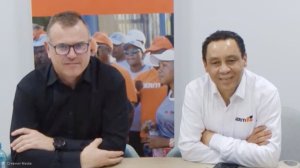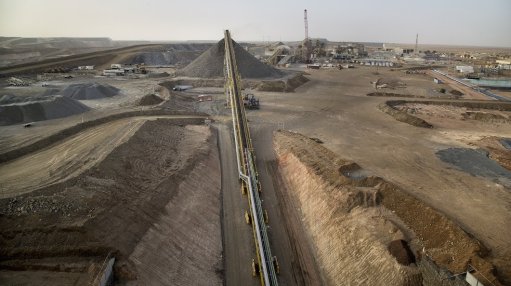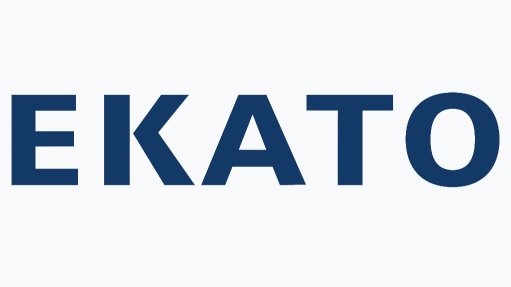Global energy winners will be those transitioning quickly and effectively

Seriti Group CE Mike Teke (right) Seriti Green CEO Peter Venn interviewed by Mining Weekly's Martin Creamer. Video: Darlene Creamer.
JOHANNESBURG (miningweekly.com) – Those who implement strong energy portfolios and grids timeously and effectively are going to be the biggest contributors to the crucial just energy transition.
That is the collective viewpoint of Seriti Group CE Mike Teke and Seriti Green CEO Peter Venn, who spoke to Engineering News & Mining Weekly in a Zoom interview. (Also watch attached Creamer Media video.)
It is Seriti Green that is building a 155 MW wind farm in Mpumalanga province, South Africa’s energy heartland, and it is Seriti Resources that will be buying that wheeled energy for use at its coal mining operations.
“We're wasting time persuading each other about whether it will be fossil fuels or renewables. It's fossil fuels and renewables, and South Africa must travel that journey,” Teke emphasised.
“It's renewables and coal," said a concurring Venn. "The money's there, the willingness is there. The industry is there. What we need is policy certainty and alignment, and whatever number you wish to throw in front of us as an industry, we're ready to take it on."
The reason Seriti Resources changed from being focused on coal was to align itself with what is underway globally.
“That energy transition is critical for the entire world and for South Africa specifically.
"Firstly, we want to be active in ensuring that South Africans benefit out of the change and enjoy the benefits of an energy mix, where we have coal, we have wind, we have solar, we have nuclear and other forms of energy generation.
“Secondly, for Mpumalanga province, it is imperative that when we traverse this journey, we're going to build two more new coal mines, and we're building renewable energy in the area.
"That is significant for the Mpumalanga people, because it provides infrastructure growth, economic activity, development and what we are showing actively as a business is that this just energy transition is not going to be business only, but we will be taking along a lot of stakeholders who are part of Mpumalanga as a population.”
Seriti Green has become the embodiment of energy transition collaboration.
Mining Weekly: Why is it so important, particularly in South Africa, that these two energy sources become joined at the hip?
Venn: Mpumalanga is the energy heartland of South Africa, and to have a just energy transition where we leave people behind is just not acceptable. The concept of an energy transition from coal to renewables is easy, but the just part is what we are focused on. Bringing the stakeholders along with us in Mpumalanga is so important, and then to get the timing right. The country as a whole has invested a significant amount of capital in transmission infrastructure over decades, and to leave that transmission infrastructure behind, if we were to transition, is crazy. We need to leverage this infrastructure. We need to be building renewables in amongst the coal mines, and if you look at the circular economy, our mine, New Denmark, is 20 km from the Seriti Green wind farm, and we're taking water from the mine, and we're repurposing the water as we build out the wind farm, so there's a whole circular economy happening within Mpumalanga, and it's important to the people of Mpumalanga.
How much of the coal that Seriti mines each year is consumed in South Africa and how much is exported?
Teke: Sixty five per cent of our coal is supplied to the power stations and 35% is exported.
To what extent will Seriti Green be able to lower the carbon footprint of Mpumalanga with the introduction of wind energy?
Venn: From a Seriti group perspective, we will almost obliterate Scope 2 emissions in the production of electricity, in that Seriti will be purchasing green electricity from the wind farm, so there is a huge reduction. But I think we need to look at it as a network across the country. Every megawatt hour that's produced abates a ton of carbon in South Africa and this project, when complete, will be 3 000 GWh. So that's a significant abatement of carbon within the South African context. From a Seriti perspective, our focus on solar is twofold. We'll be undertaking solar generation within our wind farm, and will be undertaking solar generation on our rehabilitated land within our mining areas. So it's important for us to keep being cognisant that the right statistical number is two-thirds wind and one-third solar, if you want the least standard deviation, and the country's fast on track for 90% solar and 10% wind. An energy mix is what we need, so we're going to really try and stick mostly to our knitting at Seriti Green, which is wind energy.
What regulatory and policy steps need to be taken in South Africa to enable all the citizens of this country to get the best out of the essential energy transition?
Teke: This question is very important, especially with the legislative and, after the elections, the regulatory framework that we have. A first step for me is people understanding that now we have the Department of Minerals and Petroleum Resources, and then we've got the Department of Electricity and Energy, and those two departments must align in ensuring the future of this country and when it comes to energy generation. The just energy transition, therefore, will be defined within the rules of those two departments. The second step for me is what Eskom has done with splitting the business into three. We've got generation, we've got distribution and transmission, and we know very well that the National Transmission Company of South Africa is now existing, and we need to understand what is its role into the future. Thirdly, whilst you have those two departments, you also have the Presidential Climate Commission consulting with communities, talking to stakeholders. How are we going to ensure that there's alignment for the population of South Africa to understand what the role of each one of these components is?
Seriti Green’s 155 MW R4.8-billion first phase Ummbila Emoyeni project is already under way. Given the time it took to get that going, are you still confident that Seriti Green can deliver 900 MW in the next three years?
Venn: That is absolutely our business-as-usual target as we move forward. Developing renewables in South Africa is a complex task, numerous stakeholders, but I think the better way to look at the first phase is that it's actually two projects. We're building a gigawatt worth of grid infrastructure and a 155 MW wind farm. The further megawatts of those 900 MW then we'll connect to that grid infrastructure that we're doing. To date, the vast majority of the work has been on the grid infrastructure to make sure that we can evacuate the gigawatt hours into the Eskom network and wheel it across to our clients. I’m very confident that we'll be able to move forward, and, should the policy framework allow, we could comfortably do more than that.
How is Seriti funding the energy transition and is enough incentive being given to independent power producers to do what the world so desperately needs – to energy transition?
Teke: The best thing that ever happened to us when we acquired Windlab and created Seriti Green. Seriti became the majority shareholder with 55% of the business and Standard Bank and RMB, instead of only being funders, are also shareholders. They've each taken a14.5% shareholding in the business, and then we have Peter, who is a shareholder in the business as well. It is critical to understand that that partnership plays an important role for us being able to raise money from these institutions.
You spoke the other day of local authorities needing to bill power consumers for the use of wiring infrastructure that local authorities provide. Why should this happen?
Venn: There’s nothing for free in this life. I think I've learned that the hard way. But, jokes aside, it's very important that our distribution infrastructure is looked after. We obviously need municipal reform. We cannot continue to have municipalities just making profit without adding benefit to the electricity network. Personally, I believe we need to see a much smarter distribution grid, which obviously will cost money, but in the end, having a smarter distribution grid focused on the demand and the supply side, bringing in virtual power stations, is going to lower the demand for generation across the consumer network. At the moment, us at home don't pay peak tariffs, so there's no disincentive for us not to use electricity in peak times as I well believe there should be. So, municipal reform is critical over the next couple of years for us to get a well-operating grid, and if you go look at Canberra, in Australia, their price of electricity is well below the rest of Australia, because they are 100% renewable and they have smart distribution infrastructure.
STORAGE CAPACITY
The overall project will include 800 MWh of storage capacity and about R1.5-billion of the R4.8-billion cost for Phase 1 will be spent on the grid infrastructure needed for the project, which will provide electricity to meet the needs of about 75% of Seriti’s own coal operations, as well as supplying surrounding communities with electricity, through a wheeling arrangement.
First phase construction is expected to be completed by mid-July 2026.
Of 900 MW planned, 750 MW will be wind power and 150 MW solar power.
The project is the first since the mega coal mining company acquired Windlab, which became the launch pad for Seriti Green last year.
Seriti Resources operates six large-scale, opencast and underground thermal coal mines, predominately supplying State-owned utility Eskom power stations.
The wind farm project forms part of the coal mining company’s strategy of diversifying its offering to more than coal, in a sustainable way, for it to play its role in the country’s just energy transition journey.
Seriti Resources relinquished the mineral rights over the project’s land to enable it to be built.
Ten per cent of Seriti Green’s workforce comes from the coal sector and the focus will be on skilling people from the coal sector and surrounding community, given that the wind farm will not be able to absorb the same number of employees as a coal operation.
Seriti Resources is committed to playing an active role in reducing carbon emissions while helping to manage a just transition to a low-carbon future.
Once constructed the wind farm will be helping to mitigate its Scope 1 and 2 greenhouse-gas emissions and bringing the company a step closer to carbon neutrality.
Article Enquiry
Email Article
Save Article
Feedback
To advertise email advertising@creamermedia.co.za or click here
Press Office
Announcements
What's On
Subscribe to improve your user experience...
Option 1 (equivalent of R125 a month):
Receive a weekly copy of Creamer Media's Engineering News & Mining Weekly magazine
(print copy for those in South Africa and e-magazine for those outside of South Africa)
Receive daily email newsletters
Access to full search results
Access archive of magazine back copies
Access to Projects in Progress
Access to ONE Research Report of your choice in PDF format
Option 2 (equivalent of R375 a month):
All benefits from Option 1
PLUS
Access to Creamer Media's Research Channel Africa for ALL Research Reports, in PDF format, on various industrial and mining sectors
including Electricity; Water; Energy Transition; Hydrogen; Roads, Rail and Ports; Coal; Gold; Platinum; Battery Metals; etc.
Already a subscriber?
Forgotten your password?
Receive weekly copy of Creamer Media's Engineering News & Mining Weekly magazine (print copy for those in South Africa and e-magazine for those outside of South Africa)
➕
Recieve daily email newsletters
➕
Access to full search results
➕
Access archive of magazine back copies
➕
Access to Projects in Progress
➕
Access to ONE Research Report of your choice in PDF format
RESEARCH CHANNEL AFRICA
R4500 (equivalent of R375 a month)
SUBSCRIBEAll benefits from Option 1
➕
Access to Creamer Media's Research Channel Africa for ALL Research Reports on various industrial and mining sectors, in PDF format, including on:
Electricity
➕
Water
➕
Energy Transition
➕
Hydrogen
➕
Roads, Rail and Ports
➕
Coal
➕
Gold
➕
Platinum
➕
Battery Metals
➕
etc.
Receive all benefits from Option 1 or Option 2 delivered to numerous people at your company
➕
Multiple User names and Passwords for simultaneous log-ins
➕
Intranet integration access to all in your organisation

















